The play, performed once a year on Kaisika Ekadasi in the Tamil Nadu town, is based on an episode in the Varaha Puranam. The oldest manuscript of the play available today was authored by Thiru Veerabadhra Nattuvanar, from around the 17th century.
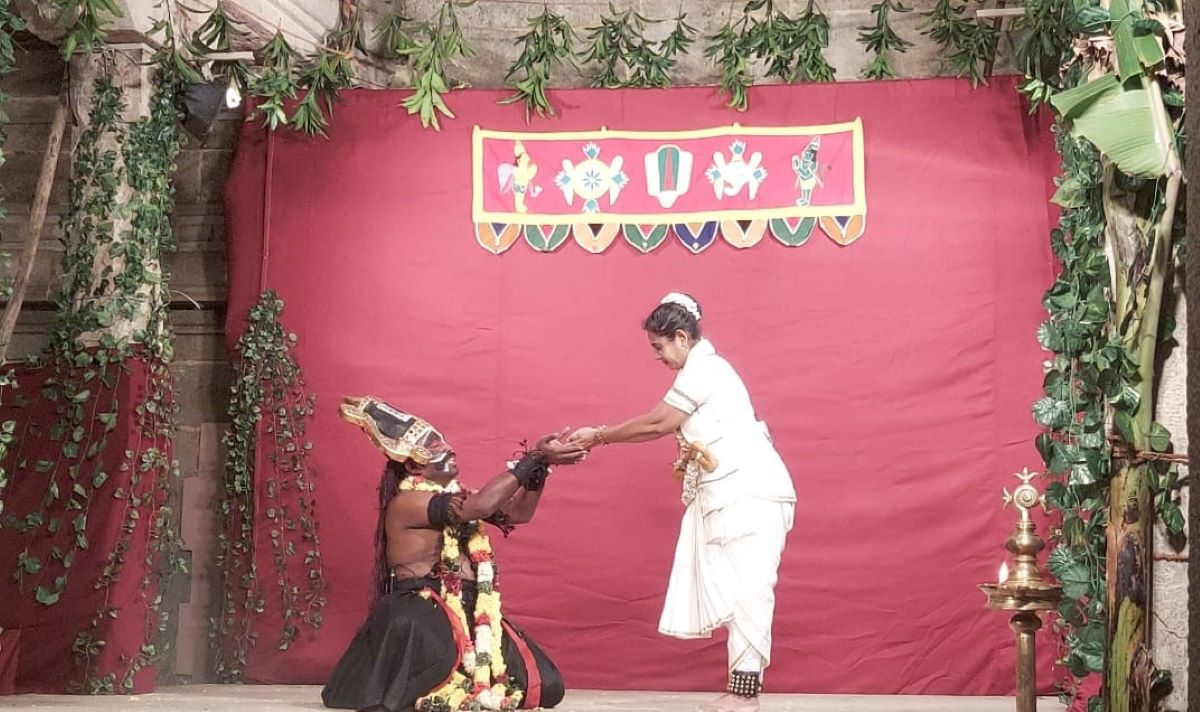
Kaisika Puranam natakam in the Thirukkurungudi Azhagiya Nambi Kovil on the day of Kaisika Ekadasi (Madhusudhanan Kalaichelvan)
Thirukkurungudi, a small but ancient temple settlement in Tamil Nadu on the foothills of the Western Ghats, is known for its centuries-old Kaisika Ekadasi play based on an episode in the Varaha Puranam.
Located not far away from the Kerala border, the town is reached in an hour’s time by road from Tirunelveli or Kanniyakumari and spots an impeccably rich rural look.
The centre of attraction in Thirukkurungudi is a highly ornate and picturesque temple or kovil dedicated to Vishnu as Sri Azhagiya Nambi Rayar or Sundara Paripooranan.
The Azhagiya Nambi Rayar Kovil in Thirukkurungudi is a Divya Desam as it has been sung about in Tamil around 1,400 years ago by the Vaishnavite Azhwar saints. Four Azhwars — Thirumazhisai Azhwar, Nammazhwar, Periyazhwar, and Thirumangai Azhwar — have sung about the temple.
Thirumangai Azhwar is believed to have spent his last days and attained moksham or salvation here.
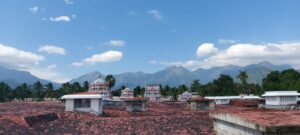
The vimanams of some of the shrines — including those for Nindra Nambi, Irundha Nambi and Kidandha Nambi — in the Thirukkurungudi Sri Azhagiya Nambi Rayar Kovil. The Western Ghats can be seen in the background (Madhusudhanan Kalaichelvan)
In addition to the main sanctum for Nindra Nambi in the Thirukkurungudi kovil, there are shrines for Irundha Nambi and Kidandha Nambi (Vishnu in his standing, sitting, and reclining postures respectively). There are also shrines for Siva as Pakkam Ninrar and Bhairavar in this temple.
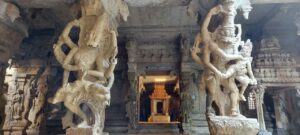
Narasimha with Hiranyakasipu depicted in sculptures in the Thirukkurungudi temple. In his beautiful pasuram on the Thirukkurungudi temple in his Tiruchanda Virutham composed much earlier, Tirumazhisai Azhwar has referred to this episode from Narasimha avataram (Madhusudhanan Kalaichelvan)
Apart from the main temple, there are two shrines for Vishnu in the town — the Thiruparkadal Nambi and Malaimel Nambi temples, the latter in a reserve forest in the Western Ghats.
Associated with the Varaha avataram of Vishnu, the Azhagiya Nambi Rayar Kovil in the town organises a unique theatre ritual tradition every year.
Coinciding with the Kaisika Ekadasi day, the 11th day of the waxing moon, in the Tamil month of Karthigai (mid-November to mid-December), the story of a great devotee is enacted as a grand ritual theatre.
The main plot is an elaboration of an episode narrated by Varahaswami to Bhoomi Devi. Documented in the Varaha Puranam, this story talks about a Vedic seer who was cursed to become a brahma rakshasa due to his negligence while chanting Vedic texts.
The oldest manuscript of the play available today was authored by Thiru Veerabadhra Nattuvanar, from around the 17th century.
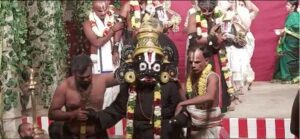
Kaisika Puranam natakam in the Thirukkurungudi Azhagiya Nambi Kovil on the day of Kaisika Ekadasi (Madhusudhanan Kalaichelvan)
As a cure, he was suggested by the celestials to stay in the woods surrounding the sacred town of Thirukkurungudi and wait for Nampaduvan, a musician devotee.
Born in a community that was supposedly lower in the societal strata, Nampaduvan exhibited unmatched devotion and observed every Ekadasi day very strictly. The Vedic seer was asked to convince him and get at least a miniscule part of the punyam from his musical offering to Sri Nambi Rayar Perumal in the kovil in the village.
Hence, the brahma rakshasa waited in the woods for eons. On the promised Kaisika Ekadasi night, he happened to meet Nampaduvan and threatened to kill him.
Nampaduvan in all humility requested that he be allowed to finish his Kaisika Ekadasi fast by visiting the temple and promised to come back and offer himself to the brahma rakshasa. He goes on to make several promises and manages to convince the demon, who finally sets him free.
The play is performed every year on the night of Kaisika Ekadasi.
It is about a Vedic seer who was cursed to become a Brahma rakshasa due to his negligence while chanting Vedic texts, and Nampaduvan, a great devotee of Vishnu in Thirukkurungudi.
(4/6) pic.twitter.com/ofY0pjjvgK
— South First (@TheSouthfirst) December 4, 2022
After his visit to Nambi Kovil in Thirukkurungudi, Nampaduvan hurries back to the rakshasa, who was now surprisingly ready to spare his life but demanded the punyam from the offerings that the former made. The devotee initially rejected the suggestion but was moved when the demon narrated his story from his previous birth.
The story shows the belief that irrespective of caste or community, the devotion of a true devotee can cleanse one of all their sins.
This story is scripted with traditional theatre elements and offered in the temple on the night of Kaisika Ekadasi.
What used to be a grand all-night event performed by the traditional temple dancers lost its lustre after the demise of the chief patron and native of the village, Thiru TV Sundaram Iyengar (or Thirukkurungudi Vengaram Sundaram Iyengar) in 1955.
Dr Anita Ratnam, a descendant of the erstwhile patron, and also a dancer and theatre person of international repute, happened to watch the presentation in 1996 and wanted to take it up for revival.
Along with Dr Prof Ramanujam, an ace theatre scholar and Koothu Pattarai fame Na Muthuswami, she managed to put the remaining pieces together and revive the ritual performance on a modest scale in 1999. The dance and dancers part of the play was fine-tuned and trained by senior dance guru Thiru Herambanathan.
From then, the annual offering became an ever-growing affair for Anita Ratnam’s Arangam Trust.
She had too many challenges to face such as identifying artists, musicians, converting a live orchestra into a recorded one, training the artists in theatre-oriented dance forms, ensuring that the traditional dialogue is maintained, conducting rehearsals, and more.
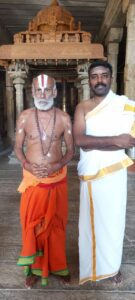
Madhusudhanan Kalaichelvan (right), the author of this article, now plays the role of brahma rakshasa in the play. On the left is the person who used to play the role of brahma rakshasa in the play earlier; he still adorns the traditional mask but does not participate in the play, and sits behind the stage after his entry and introduction
This year, in 2022, Kaisika Ekadasi falls on Sunday, 4 December. The play will be conducted on Sunday night/Monday early morning.
The otherwise quiet Thirukkurungudi will gear up to host people from far and wide on Kaisika Ekadasi.
Every house turns into a chatram allowing the pilgrims shelter through the day and watch Kaisika Natakam from the Varaha Puranam at night, a one-of-its-kind theatre performance ritual that continues to evoke devotion and faith in the audience.
All the roles except that of the brahma rakshasa in the Kaisika Puranam play in Thirukkurungudi are performed by women.
The two people portraying the brahma rakshasa and
Nampaduvan in the Kaisika Puranam play also fast the entire day — observing the Ekadasi vratham — before performing late in the night.
The author of this article now plays the role of brahma rakshasa in the play.
For more on the town, temple and its traditions, you can listen to a talk by this author (mostly in English):
(Madhusudhanan Kalaichelvan is an architect and conservationist interested in Indian heritage and culture)

Mar 01, 2024

Feb 28, 2024

Feb 22, 2024

Feb 18, 2024

Feb 12, 2024

Feb 11, 2024